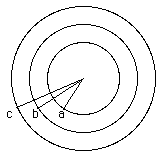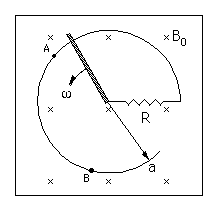
Home

WarmUp

What is Physics Good For?

Puzzle

Course Information

Communications
|
 |
 Questions (9 points each)
Questions (9 points each)
Q1 An ideal 10 V battery connected across a resistor
generates 1000 J in 20 seconds. The value of the resistor is
a) 1 Ohm.
b) 2 Ohms.
c) 50 Ohms.
d) 100 Ohms. |
Q2 A wire carries current from north to south. An electron is located directly below the wire and is traveling straight up. The force on the electron is
a) To the North
b) To the South
c) To the East
d) To the West
e) Zero
f) None of the above |
Q3 A series RLC circuit has XL < Xc. Which of the following is true?
a) The phase is zero.
b) The phase is negative.
c) The power factor is zero.
d) The power factor is positive.
e) Two of the above.
f) None of the above. |
Q4 The image you see when you look at yourself in the mirror is
a) real and erect
b) real and inverted
c) virtual and erect
d) virtual and inverted |
Problems (44 points each)
 P1 A charge distribution consists of three charges located at the
corners of a triangle. The charges are q1=q2 = 2 microcoulombs
at the points (-1,-1) and (1,-1) and a third charge q3 at the
point (0,1).
P1 A charge distribution consists of three charges located at the
corners of a triangle. The charges are q1=q2 = 2 microcoulombs
at the points (-1,-1) and (1,-1) and a third charge q3 at the
point (0,1).
(a) Find the charge q3 that gives a zero electric field at the
origin.
(b) Find the total potential energy of this system.
|
P2 Three moles of a monatomic ideal gas begin at volume V = 0.1 m3 and
1 atmosphere. The gas is taken through the following cycle.
- Volume doubled at constant pressure
- Pressure reduced by a factor of two at constant volume
- Volume reduced by a factor of two at constant pressure
- Pressure doubled at constant volume
a) Draw a P-V diagram for this cycle
b) Calculate Q, W, and the change in internal energy for each of the four
processes. |
 P3 A solid insulating sphere of radius a carries a uniform charge density and has total charge Q. Concentric with this sphere is a conducting spherical shell with inner radius b and outer radius c. The conducting shell carries a total charge 2Q.
P3 A solid insulating sphere of radius a carries a uniform charge density and has total charge Q. Concentric with this sphere is a conducting spherical shell with inner radius b and outer radius c. The conducting shell carries a total charge 2Q.
a) Find the electric field in each of the regions: r less than a, r between
a and b, r between b and c, and r greater than c.
b) Find the surface charge density on the inner and outer surfaces of the
spherical shell. |
 P4 Consider a series RLC circuit. The source supplies a voltage of V=150cos(120
P4 Consider a series RLC circuit. The source supplies a voltage of V=150cos(120
 t+ t+ ) volts, maintaining a current I = I0cos(120 ) volts, maintaining a current I = I0cos(120 t). The values of the circuit elements are R = 30 Ohms, L = 175 mH, and C = 75 microfarads. Find t). The values of the circuit elements are R = 30 Ohms, L = 175 mH, and C = 75 microfarads. Find
a) The frequency
b) The impedance
c) the phase angle 
d) The average power delivered by the source.
e) The current amplitude. |
P5 An object is placed 30 cm to the left of lens #1, which has focal length f1 =10 cm. Ten centimeters to the right of lens #1 is lens #2, which has of focal length f2 = -10.
- Is lens #1 converging or diverging? How about Lens #2?
- Find the location of the final image produced by these two lenses together
- Find the total magnification of the system.
- Is the final image real or vitual? Erect or inverted?
|
 P6 The figure to the right shows an apparatus consisting of a conducting rail that is bent into a circular arc of radius a = 0.5 m, and a resistor of value R = 10 Ohms that is connected to the arc at one end, and to a pivot point at the other end. A conducting rod is connected to the resistor at the pivot, and slides along the rail near its other end. The entire apparatus is in a uniform magnetic field of magnitude B0 = 0.2 T that is perpendicular to the plane of the loop (into the page). The rod rotates around the pivot at constant angular velocity of 2 rad/sec. Please find
P6 The figure to the right shows an apparatus consisting of a conducting rail that is bent into a circular arc of radius a = 0.5 m, and a resistor of value R = 10 Ohms that is connected to the arc at one end, and to a pivot point at the other end. A conducting rod is connected to the resistor at the pivot, and slides along the rail near its other end. The entire apparatus is in a uniform magnetic field of magnitude B0 = 0.2 T that is perpendicular to the plane of the loop (into the page). The rod rotates around the pivot at constant angular velocity of 2 rad/sec. Please find
- The direction of the induced current through the resistor.
- The magnitude of the induced current.
Note:You may ignore what happens as the rod pases over the gap in the loop.
|
| Other types of problems to look out for: Ampere's law, Inductors, DC circuits, Capacitors, Gas kinetics, Mirrors, Prisms, Adiabatic processes, Calorimetry, Biot-Savart Law, and Magnetic forces on wires and charges. Your best guides
are the problems worked out in recitation and the test prep problems. |
This site is made possible by funding from the National Science Foundation (DUE-9981111).
©2000 IUPUI, all rights reserved.
|
|





